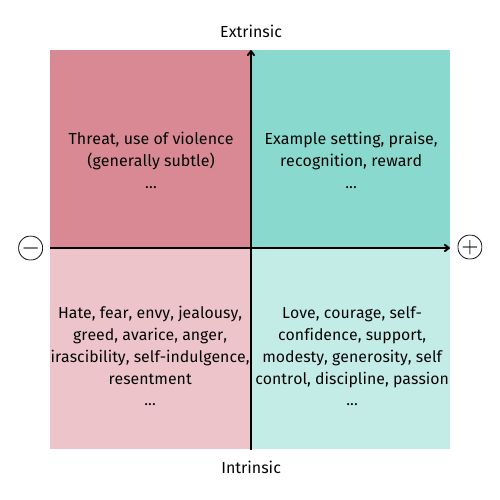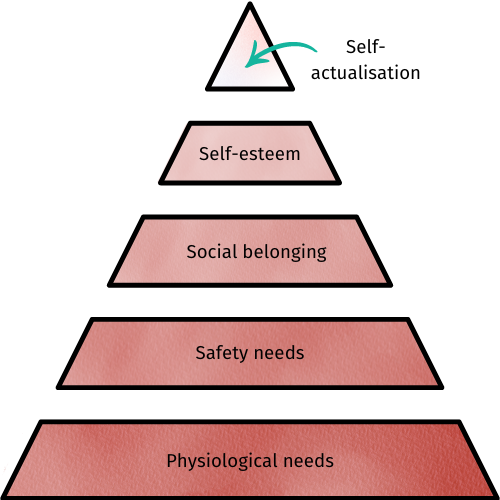Theory "Motivation"
Know the motivations¶
Motivation or demotivation is our constant companion, whether at work or in our private lives. Regardless if it's ignoring the snooze button on the alarm clock and jumping into our trainers to go for a run, or answering that nerve-wracking email on Friday afternoon rather than waiting until Monday. In both cases, we have different motivations: for example, when you motivate yourself to exercise in the morning your motive is to become more persistent so that you are no longer out of breath running after your toddler. Your motivation comes from within. If you force yourself to answer an email just before the weekend instead of doing it on Monday, you might do it because you want to avoid being confronted with an angry customer on Monday. Your motive comes from the outside.
But you can also look at these scenarios with a different perspective: Maybe you do sports because you want to win a competition. In this case, the motivation comes from the outside. And maybe you write the email on Friday because it feels good to have all of your tasks done for the week and have a weekend ahead of you where you don't have to think about your work with a guilty conscience. In this case your motivation comes from within.
As you can see, motives can not only differ from scenario to scenario, but also from person to person.
Now let's get back to the agile project: as different as the professional qualifications are, so are the motives of the employees. In an agile project, success is essentially dependent on a functioning team; in Scrum these are the Developers, who must be able to cooperate smoothly with each other. Incentives are a prerequisite for goal-oriented and motivated teamwork. The team members must believe in the project and that their participation offers them personal advantages.
These benefits can be the following:
- Job security, because the project helps the company to stay in business,
- building knowledge, because you learn new things and gain experience during the project,
- career advancement,
- a financial bonus,
- honest praise, or
- or personal recognition.
Most of the time, team members work on a project because they have to, but sometimes employees can decide for themselves whether they want to work on a project. In both cases, it is best if a team member can derive some personal satisfaction or benefit from the success of a project. If the member makes the decision to work on the team themselves, it is more likely that personal benefit will occur. But even if an employee has to work on the project, they can get personal satisfaction from it. Motives can be that the team members notice that their performance increases due to the new challenge, even if it was unwanted. They notice the influence they have on the project with their work or that they themselves notice that they are part of an excellent team.
Motivating team members¶
Opinions differ on the truly motivating effect of incentives by management. It is doubted that incentive systems, such as bonuses, have a lasting positive impact on employees' attitudes towards their work. Accordingly, sophisticated motivation techniques can lead to a situation where incentives have to be continually increased in order to have a motivating effect on employees. Other possible side effects of individual incentives are interpersonal problems such as resentment or envy. Ideally, employees should be personally motivated and this process should be encouraged.
In Scrum, the Scrum Master is in demand. Since he has no disciplinary influence on the Developers, only positive motivators are available to him. In principle, only line managers are responsible for motivators that have a negative effect (threats, warnings, etc.).
A motivation matrix can be used to identify different motivators for project staff. In general, there are intrinsic and extrinsic influencing factors on people, each can have a positive or negative nature.
But what exactly is the difference between intrinsic and extrinsic motivation? From the examples given above you have already learned that motivation can come from within (= intrinsic) or from outside (= extrinsic).
If you are intrinsically motivated, you do something for your own sake. Curiosity is satisfied, you learn something new or you set yourself a challenge. Quite banal: you do something because it gives you pleasure. Extrinsic motivation comes from external influences. You do something because you hope for a reward or fear a punishment.

Motivation of agile teams¶
Working in agile teams can be particularly motivating because teams that work in an agile way usually also (should) work in a self-organised way. Through self-organised and self-determined work, the successes achieved by the team become personal successes. This creates a positive feeling among the team members. Self-motivation goes hand in hand with self-organisation and personal success. With the feeling of success, the positive attitude towards work increases and there is an incentive to hang in there. The goal of a Scrum Master, or a project manager when using Kanban or XP, should be to keep self-motivation as high as possible, because self-motivation is more valuable than motivation by others. However, this does not just mean letting the team do what they want but also giving feedback, providing help where needed and giving advice when needed. If motivation does wane, the benefits of the project should be emphasised. Furthermore, appreciation should not be neglected. This includes not only appreciation for the work done but also for the time of the team members. Everyone should be aware that team members don’t only live for the project but have a private life that should not suffer because of the project. As you have already learned, there is a separate point for this in Extreme Programming under Team Techniques: Overtime should be avoided or reduced in time.
Motivation plays an important role, not only in the project team or the team of developers.
The Scrum Master or the project manager should not be demotivated either. Are you a Scrum Master or project manager on an agile project? Then you should start with self-motivation. If you are demotivated yourself - e.g. because you don't see the benefit of the project, have to work overtime and don't get any recognition, then you can't expect the rest of the team to be any different.
Motivation theories¶
Since motivation plays an important role in many areas of our lives, there are many theories on this topic. Probably the best-known theory is Maslow's hierarchy of needs, which we would like to introduce here. In addition, we will also give you an insight into Herzberg's two-factor theory. Both theories are described in relation to work in general and not to projects in particular, since the fulfilment of the individual need levels in Maslow's hierarchy of needs and the expression of the factors in Herzberg's two-factor theory depend strongly on the project context, the environment and also the project culture.
At this point we want to emphasise that much of the insights gained through these theories is only methodological and the relationship between job satisfaction and job performance cannot be empirically proven.
Maslow's hierarchy of needs¶
Abraham Maslow's hierarchy of needs provides a needs-based framework for human motivation. It shows that the lower needs - which include financial security - are basic needs. Only if these needs are met, the needs at the next level can be satisfied.
Maslow's hierarchy of needs in an international context
The levels are independent of culture, only the order may be different in some cultures. In this sub-chapter we refer to the original structure of the hierarchy of needs.
Maslow's hierarchy of needs is divided into five levels. Four of them are so-called deficiency needs and one is a growth need. At the bottom are the physiological needs. For example, in the work environment these include daylight and the possibility to satisfy hunger and thirst. At the second level are the safety needs. These include a permanent employment contract and the security of continued payment of wages in case of illness. This is followed by belongingness and love needs: people feel more comfortable when they have the feeling of belonging to a social group. Therefore, in the work environment it is important to promote a good working atmosphere and strengthen the team's feelings. The esteem need is the individual need, or social recognition, which describes that people are motivated by recognition and appreciation, which could be bonuses or praise, for example. At the top of the hierarchy is self-actualisation. Unlike the other four needs, this need is a growing need. This means that this need can change or develop further once the desired state is reached. On the other hand the other four needs are deficiency needs, which means that there is a deficiency which has to be removed. When this deficiency is removed or the need is satisfied, people turn to higher needs.

The two-factor theory according to Herzberg¶
The two-factor theory was developed by Frederick Herzberg and is a theory on work motivation. This type of motivation is a particular factor in the performance and quality of work. Work motivation is influenced by motivators and comes primarily from work content. These represent all the activities needed to perform a task. This can include how monotonous or varied a task is or how much responsibility one has. Motivators therefore change satisfaction, but do not automatically cause dissatisfaction.
There is a second factor, the so-called hygiene factor, which focuses on the context of the work. This includes salary, management style but also the interpersonal relationship between employees. If positive, this factor can prevent the emergence of dissatisfaction, but never generate satisfaction.
In this context, these two factors represent two independent characteristics. From the point of view of hygiene there is dissatisfied - not dissatisfied, in the case of motivators not satisfied - satisfied. Both characteristics must be present to ensure job satisfaction. Job satisfaction is the positive attitude of a person in relation to work. Satisfaction therefore does not exist if there are no reasons for dissatisfaction.
The combination of the two factors can, among other things, lead to an ideal situation in which employees are highly motivated and have as few complaints as possible. On the other hand, the worst situation occurs if the hygiene and motivation factors are low. This leads to unmotivated employees with many complaints.
Motivation problems¶
Even in organisations use incentive systems, there are often employees who do not adhere to performance factors and targets. This is because these organisations have recognized the importance of employee motivation but are inconsistent in implementing such measures. A bonus that almost completely disappears after taxes are deducted from the paycheck does not motivate an employee to optimise their work processes. And someone who can determine his own working hours on paper but in practice has to spend the core time in the office will not concentrate on developing new products but grumble about being stuck in rush-hour traffic every evening.
Companies are still reluctant to introduce real change because they fear that it will challenge power structures and hierarchies. However, the application of agile project management can and should already lead to an initial change in thinking, which can then also lead to changes in the structures of the company or at least to changes in the mindset of those responsible in the company.